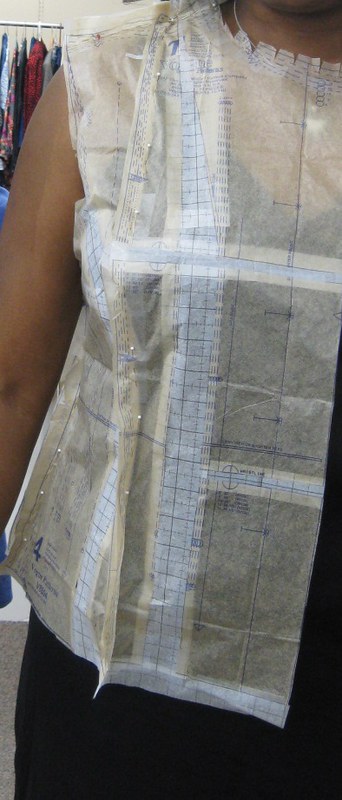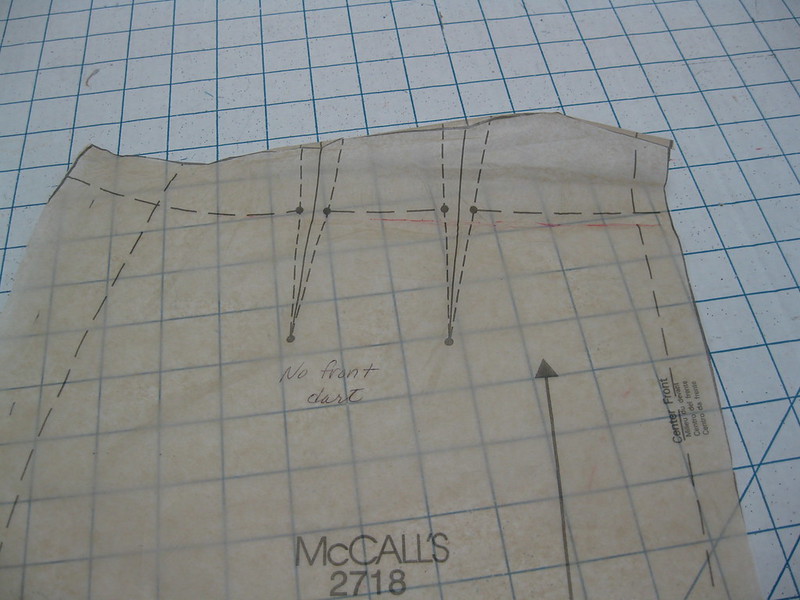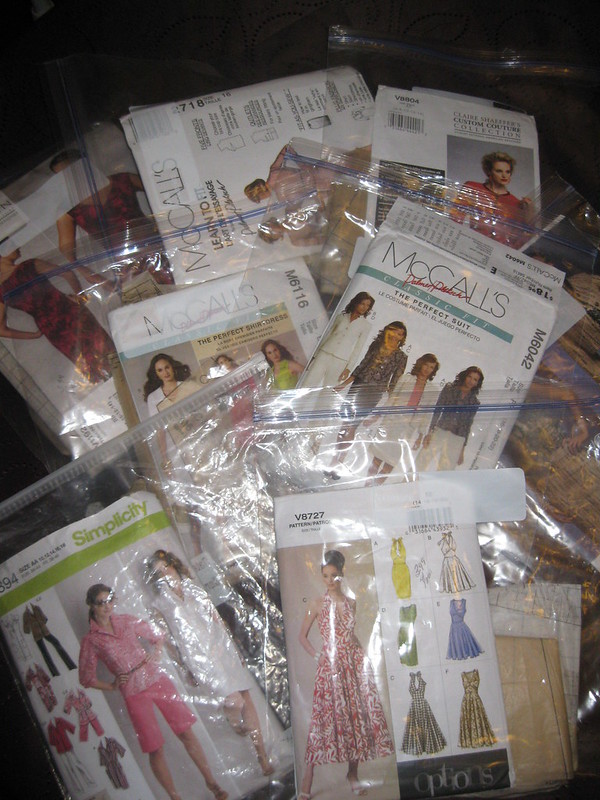 |
| FBA on V8804. It's not hanging perfectly because I'm avoiding the pins at the side. |
The Palmer/Pletsch (PP) fit workshop was everything I had
hoped for and more. I purchased my first
PP pattern sometime in the 80’s. Their
guide sheet contains additional information about fit and construction. Over the past 10 years, I purchased about two
dozen PP patterns and the “Fit for Real People” book. The patterns and book have been a tremendous
help to me with making fit adjustments.
This class builds on that knowledge.
Each day Pati/Marta brought garments from there private
collection to help illustrate several useful points about fit, versatile
patterns, design changes, and fabric use.
For example, the first day of class both Marta and Pati wore their rendition
of Melissa’s jacket (M6294). They had
added topstitching to the back yoke that emulated the chevron affect that the
striped fabric produced in my jacket.
On the first day, we received a lesson on the history of
pattern companies to help us understand the evolution of pattern sizing and how
the industry has struggled in recent years to maintain a viable customer
base. We also received a lesson on the
resurgence of the home sewer. In recent
decades home economics has been removed from many of the high schools in North
America. Today, many twenty and thirty
somethings are making their own clothes due to the poor quality of industry
manufacturers.
Each person was taught how to measure themselves before
selecting the appropriate pattern size.
This was accomplished using the high bust measurement. This measurement correlates to the bust
measurement indicated on the pattern envelope.
Using this measurement is the best way to select a size to fit your neck
and shoulders. We used M2718, which includes a sloper, dress, skirt, and blouse
pattern. The sloper has multiple bodice
fronts ranging in cup sizes A to DD. If
you are a DD + use the front bodice for a B cup and make FBA. This was a great learning experience. The guide sheet provides excellent instructions
on how to use the pattern as well as how the make the adjustments. BTW-
Each of the big four offer a version of this sloper. The pattern companies also use this sloper to
create all patterns.
 |
| Pati and Susan. Susan brought this jacket for a lesson in fitting. |
I was surprised by some of my fitting adjustments. I should make a broad shoulder adjustment
(back) easing or darting at the shoulder to match front shoulder seam; make
deeper seam allowance at side bodice as needed; slightly shorten right side of
bodice to match length of torso; shorten front skirt at the waist instead of
the bottom to even out the hemline; and initially, I measured for a size 16
(later discovered that a 14 will do in most cases.) In the past, I would do: a sway back adjustment, a full bust adjustment,
and some length adjustments; some shorten (crotch area), and a prominent
shoulder blade adjustment. The exercise
produced slightly different adjustments for me.
Of course, I will test the new adjustments and share the results with
you. I do recommend the exercise
especially to new sewers. It will reveal
important information about adjustments needed for other patterns you want to
sew from.
 |
| New stitching line indicated in red for my skirt pattern. |
Another day, they taught the difference between princess
seam and a side seam. It’s a subtle
difference, but a difference just the same.
I wasn’t aware that there was a difference. (More on that as I post my next batch of
sewing projects.)
 |
| My Fitted Patterns |
As part of our supply list, we were to bring a few patterns
of choice to fit during class. I chose
to bring a group from my collection that were challenging to me. (S2894, V1192, V1127, and V8727) These were challenging because I didn’t quite
know how to go about making the FBA without a huge dart. I wanted to keep the same design lines. These patterns were perfect candidates for
rotating the dart or rotating the FBA excess to the gathers or pleats. All were successfully fitted using the PP FBA
techniques. The Vogue dress V1192 was the most time
consuming. Marta taught me how to rotate
the bust dart into the pleats. Then she
taught me how to readjustment the pleats to form the proper drape. This FBA contained a lot of steps, but it was
doable. Other patterns adjusted during
the workshop are: M6116, M6042, and
V8804. I was pleased to get so many
altered during the time of the workshop.
 |
| FBA before rotating the dart to the neckline (V8727 Blouse). |
 |
| Dart rotated to the neckline to be gathered (V8727 Blouse.) |
I feel I covered a fair amount of details about my
experience at the four day workshop. I don’t want to give away the farm. There were many lessons learned. My plan is to use the techniques and
practices learned in upcoming sewing projects. I want to quickly incorporate my
new skills into my sewing. The fitting
exercises may be presented as a tutorial to show more details from point A to
point Z. Meanwhile, there is more to
come on fabric stores, notions, color analysis.
Below are some important and helpful tips/lessons learned
about fit and sewing are below:
- Learn how to select the correct pattern size using the high bust measurement. It will save you from struggling with neck and shoulder adjustments.
- Start the tissue fit process from the back; then work your way around to the front, shoulder and sides.
- Know the difference between style and wear ease. Most patterns have the finished garment measurements for the bust, waist, and hip printed on the pattern. The measurements will be different based on the style of the garment. Sometimes it’s okay to absorb some of the style ease for small fit issues. But if too much of the style ease is used for wear ease, the design of the garment may become distorted. So it is best to do the fit adjustment rather than “cheat” by overly using the style ease.
- Dart manipulation – sometimes you have to make two or three at the bust area instead of one. Or you may need to change the angle for a more flattering appearance.
- Absorption of FBA dart by rotating into pleats or gathers. If you want to maintain the style lines of a garment, you can rotate the excess into the pleats or gathers. Some adjustments may be required to get the right drape, but it is doable. Test it.
- The Palmer/Pletsch fit techniques work with other patterns brands. These techniques have helped solve some of my fitting issues. The “Fit for Real People” is a great resource to have in your library.
- Learn to read the wrinkles. They point to the area where fit adjustments need to occur.
- Take a Palmer/Pletsch fit workshop. It’s worth it. The books are great, but the hands-on-classroom learning is outstanding. You will have Pati and Marta to help guide you through the difficult parts.
- Don’t be afraid to try something new. Find what works for you.
- The proper tools make fitting and sewing easier. Good reference materials and notions can make a world of difference in your finished garments.
- While I was in Oregon, I purchased the Full Busted and Fabric DVD’s. I also purchased “The Business of Teaching Sewing” for the Teacher Certification Workshop (July 18th), Grid Tracing Paper, and “Couture Sewing” book. Books and other products can be found on the Palmer/Pletsch website if you are interested.
That’s all for today!
Happy Sewing,
C
C

Thanks so much for a very interesting post, and what a great opportunity to learn from them. I find their books so useful. Fun way to spend your summer vacation. (at least sounds fun to me!)
ReplyDeleteThanks for sharing your awesome sewing venture. Looking forward to your fabric & notions
ReplyDeleteWhoa! If this is a fraction of helps you received during the workshop, I can't even imagine it ALL! This post really piqued my interest, friend. I think I will be studying a particular pattern or two that are bugging me right now. I feel inspired! THANKS!
ReplyDeleteThanks ladies. I'm glad this post is useful and/or inspiring.
ReplyDeleteWow, this was really packed with information. A couple questions: a) what is a "sloper" and how is that word pronounced? b) Why the rotation of the FBA side seam cut to the neckline? I'm not understanding the reasoning for it.
ReplyDeleteThanks again, everyone. Anonymous - Here is a link to a Threads article that provides the meaning of a sloper: http://www.threadsmagazine.com/item/4498/the-merits-of-a-basic-fitting-pattern/page/all
ReplyDeleteIt is pronounced the same as the mathematical terms: point-slope or slope intersect.
The purpose of the rotated FBA excess is to eliminate the dart at the side seam.
Thanks for asking,
Cennetta
It sounds like you had a wonderful time and a fulfilling experience. It's empowering to have a good understanding of how to fix pattern to fit well. Great post.
ReplyDeleteSuper explanations to my questions, Cennetta, and great article. Given this new info, I'll rethink how I might use the muslins I save. Thank you, very much.
ReplyDeleteThanks for sharing all of this with us! This was an amazing adventure for you and I can't wait to see how it translates into your sewing!
ReplyDeleteGreat information and it's only part of what you learned. I don't have a desire to go back to college for a degree - nothing that I'm that passionate about. But I would love to go for a sewing/fit workshop such as this. Thanks for the helpful information. I'm tagging this post for future reference...and keeping this workshop in mind for my 'someday.'
ReplyDeleteLucky you going to Palmer/Pletsch workshop. I got their Craftsy class and fitting book (which has become my go-to guide), but it would be so helpful to have hands-on guide through the fitting process.
ReplyDelete